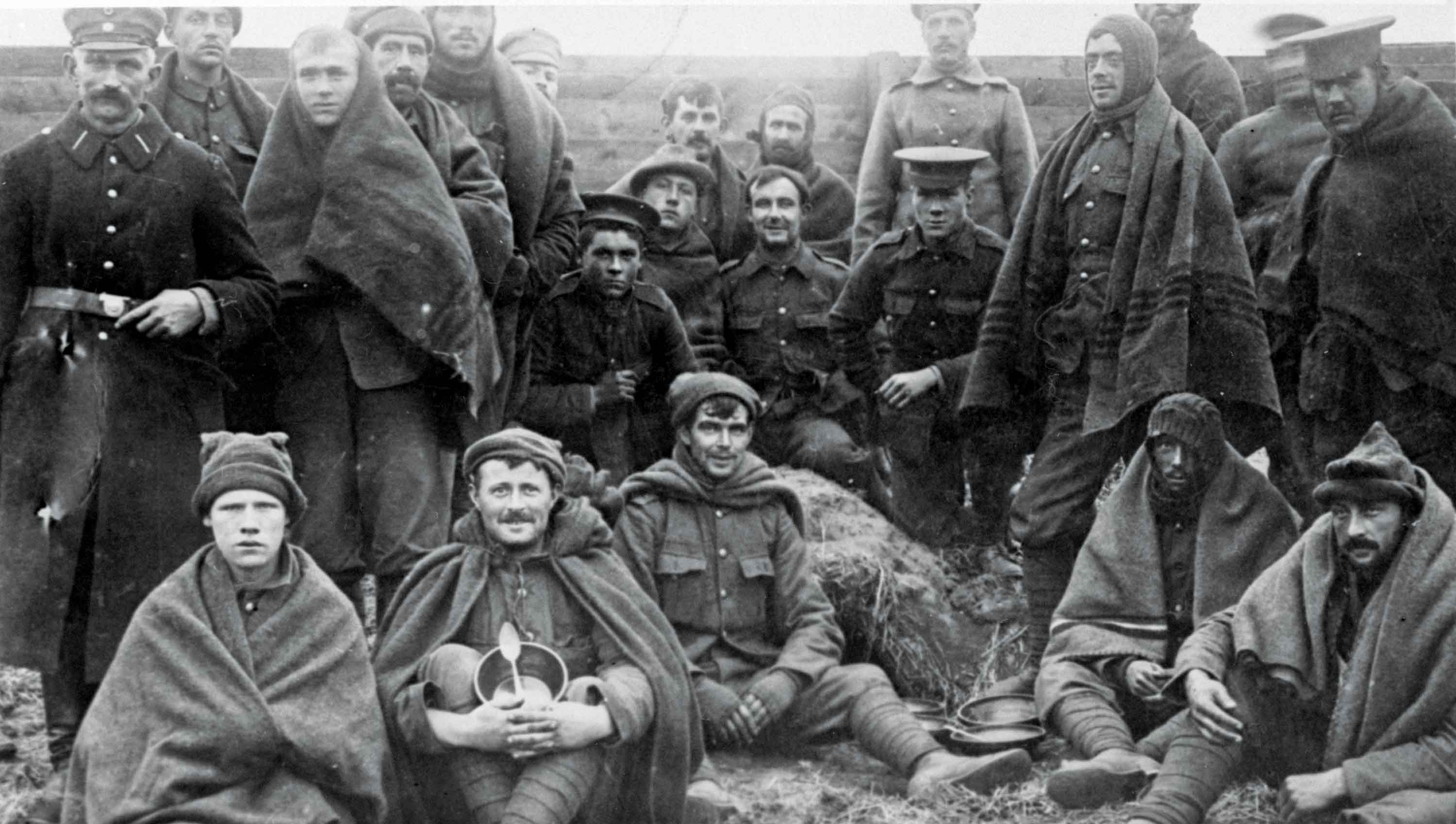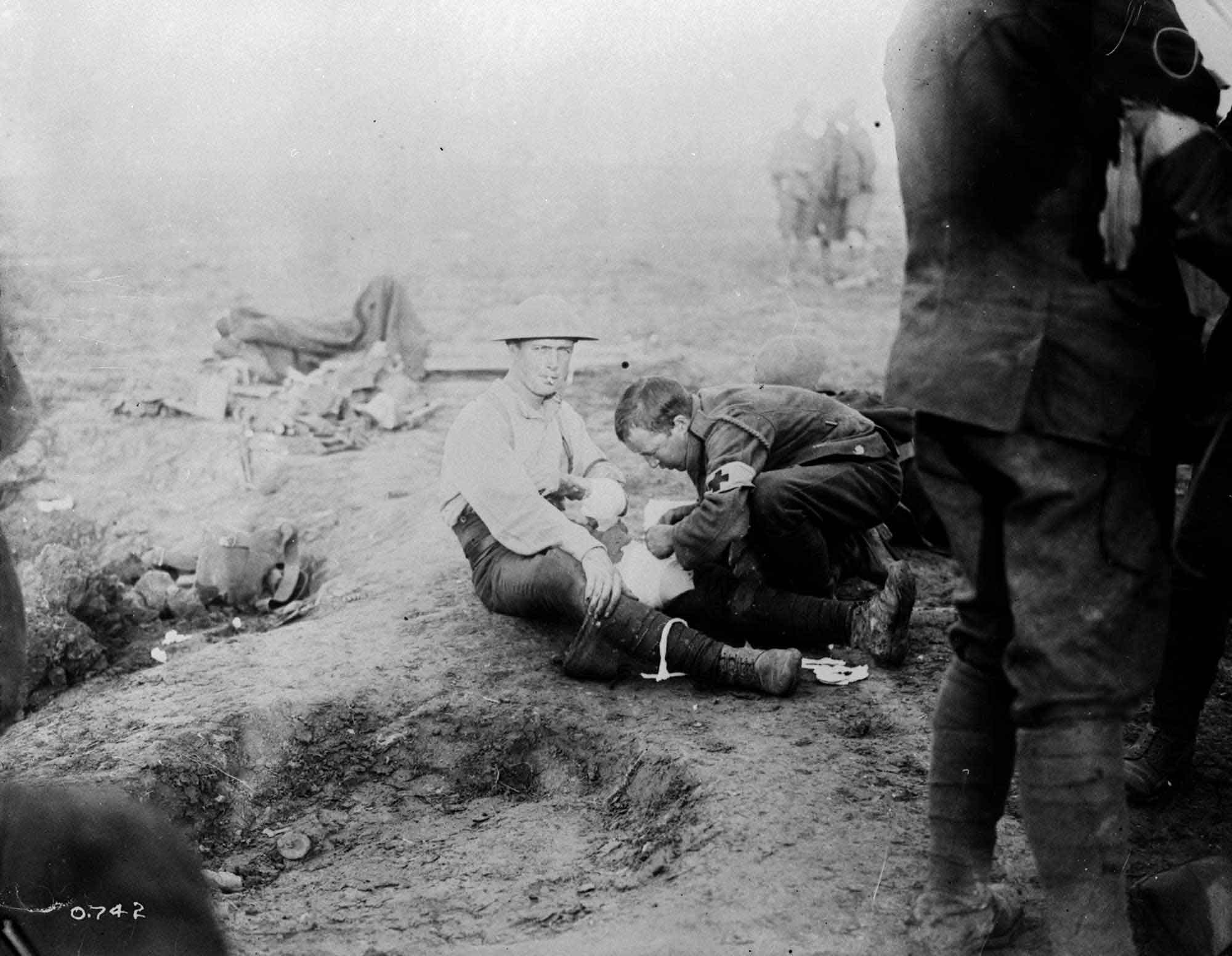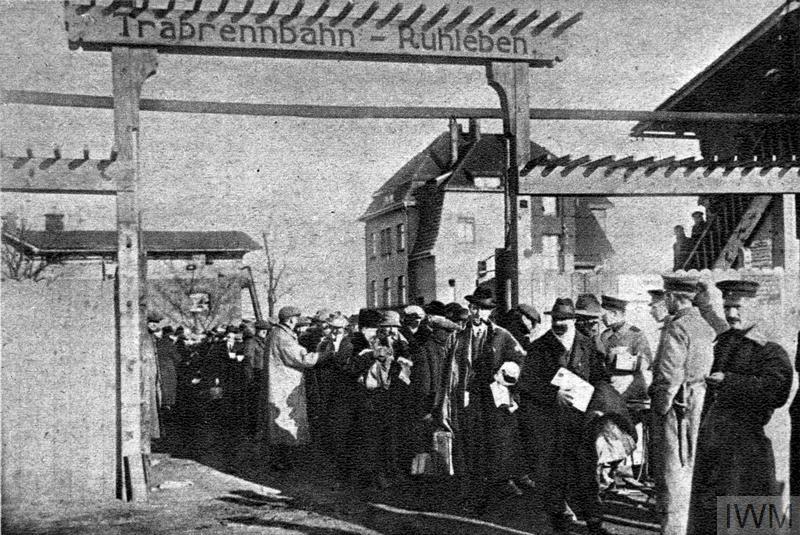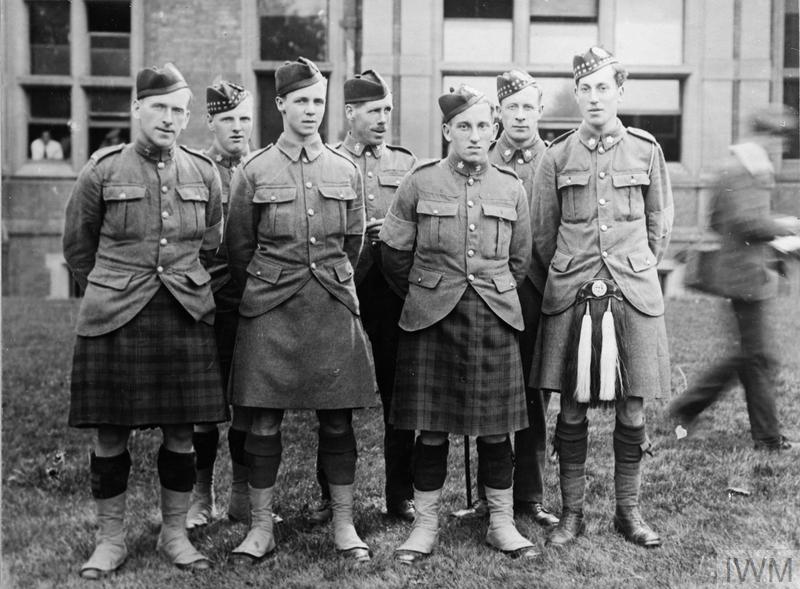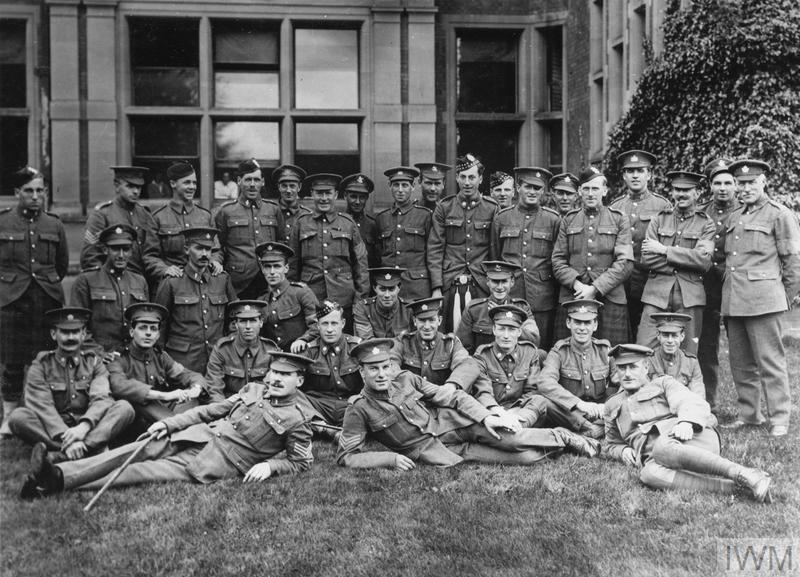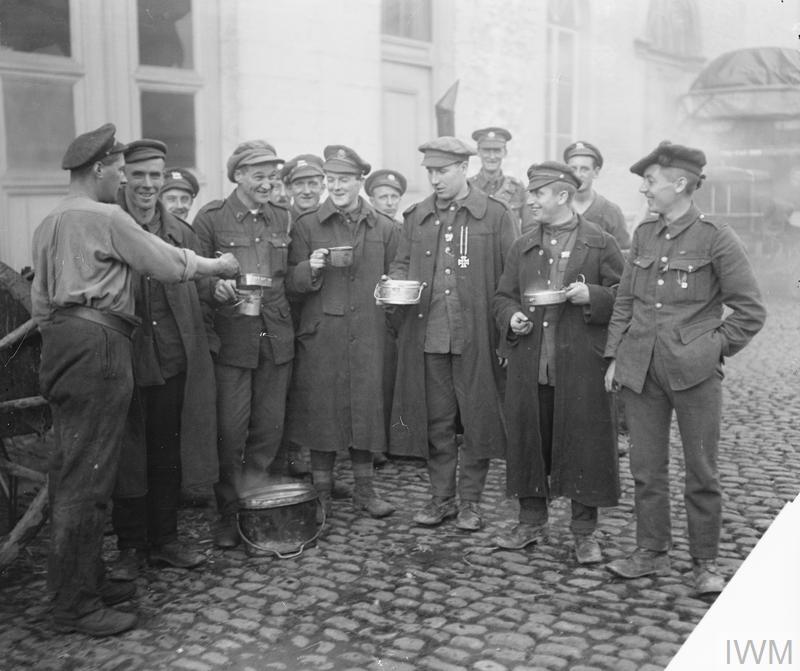PART I: THE GREAT WAR
Behind Barbed Wire
By Sharon Adams
A small cheese sent in a relief package from home was key to survival of two starving Canadians in a prisoner-of-war camp more than 250 kilometres from the Dutch border in Germany.
“It was one of the cream cheeses, so popular in Canada, no bigger than my closed hand,” Lance-Corporal Edward Edwards wrote in his 1918 memoir, The Escape of a Princess Pat. The food was welcome, but the real treasure was the compass concealed inside, no small contribution to the happy end of his third wet and miserable cross-country escape attempt in the summer of 1916.
Edwards was one of the few members of the Princess Patricia’s Canadian Light Infantry to survive the fighting at Frezenberg Ridge east of Ypres, Belgium, on May 8, 1915, part of the Second Battle of Ypres. When their trench was overrun, the Canadians were shot, bludgeoned and bayonetted by Prussian troops; Edwards survived only because an officer arrived to stop the massacre.
Edwards spent the next 15 months as a PoW, as subject and witness to cruel and inhumane treatment.
He was one of 3,847 or so Canadians taken prisoner in the First World War—just a statistical blip among the estimated seven million or so captives, including about two and a half million held by the German Empire.
Those numbers are a historical anomaly—throughout most of human history, death or slavery was the fate of most captured soldiers (although nobles or the very wealthy might be ransomed).
Seeing to captives’ well-being rose slowly to the moral high ground. In the mid-1600s the Treaty of Westphalia called for release of prisoners without ransom. Over the next two centuries, the Western world began to consider captors’ duties toward prisoners, believing “civilized” societies did not kill prisoners, but locked them up for the duration. High-born prisoners and senior officers were even allowed to live outside prison, honour-bound not to escape.
Gradually, combatants began exchanging prisoners. During the South African War, the Boers often disarmed and released captives, thus avoiding the need to guard them and cutting down on the number of mouths to feed on scarce provisions.
Modern attempts at “civilizing warfare,” as Desmond Morton put it in Silent Battle, began with creation of the International Red Cross and the Geneva Conventions of 1864 and 1906, events spurred by concern over the 40,000 wounded soldiers left suffering on the battlefield at Solferino, Italy, in 1859.
The Red Cross took on a major role looking after prisoners’ well-being in the First World War. National Red Cross societies collected food, clothing and money for prisoner relief, which were sent in parcels to individual prisoners by the International Committee of the Red Cross (ICRC). Each PoW camp sent prisoner information to the ICRC’s International Prisoners-of-War Agency in Geneva, Switzerland, which in turn alerted the prisoner’s government. It could take a long time for a family to learn the fate of a loved one. The Red Cross also provided some of the inspectors who began visiting camps in 1915, although “there was little agreement as to how effective these [inspections] actually were,” wrote J. Clinton Morrison, Jr. in Hell Upon Earth: A Personal Account of Prince Edward Island Soldiers in the Great War, 1914-1918. The ICRC also tried to ensure that every country respected the rights of PoWs, even publicizing alleged breaches of agreements.
The Geneva agreements stipulated that the wounded, medical attendants and chaplains would no longer be considered combatants, and that they and medical facilities were not to be attacked. Captors were responsible for medical treatment of wounded prisoners and speedy exchange of medical personnel and chaplains.
The Hague Conventions of 1899 and 1907 called for humane treatment of prisoners and made governments, not individual captors, accountable. Prisoners’ personal possessions must not be confiscated. Minimum standards for food and lodging were established. Prisoners (except officers) could be required to work, but not on anything connected to operations of war, like manufacturing munitions. They had to be paid for their labour, although the cost of food and lodging could be deducted from wages. They could be disciplined for trying to escape.
The major parties in the First World War signed these agreements (although the latest Hague convention provisions were not in force as not enough countries had signed on). But good intentions easily melt under war’s hot emotions.
Edwards had the misfortune of being captured just when a tale was making the rounds among German troops of Canadians slitting throats of German wounded. Edwards was in a group of 10 Patricias captured by the 21st Prussian Regiment. There should have been more.
“Becoming a prisoner was one of the most dangerous acts on the battlefield of the Great War,” historian Tim Cook wrote in a 2006 article in The Journal of Military History.
Killing of prisoners was banned, but “it was difficult for soldiers to alternate between the frenzy of killing and the offering of mercy.”
Sometimes officers, including Canadians, told their troops not to take prisoners; sometimes soldiers would see red when a buddy was killed; sometimes troops would avenge a real or rumoured atrocity.
The Germans poured into the Patricias’ trench in waves from all sides, said Edwards, “and as they came on they trampled our dead and bayonetted our wounded.” Two privates were shot in the head. A young soldier from Winnipeg put his hands up in surrender and “his captor placed the muzzle of his rifle square against the palm and blew it off.”
Edwards draws a distinction between killing someone in the heat of battle and murder, crediting the killing of one comrade “to the whimsy of our captors [as] the fight was two hours old and he was doing the bidding of his captors at the time.”
“You fellows are lucky,” a German soldier told Edwards. “Our orders were to take no Canadian prisoners.” Under interrogation, an officer said to him, “You’re the fellows we want to get hold of. You cut the throats of our wounded” at Saint-Julien, Belgium. “I said, and quite truthfully, that we had not been at Saint-Julien,” wrote Edwards. “We were aware of the story of the crucifixion of [a Canadian at] Ypres…for its truth I cannot vouch. How far other regiments may have gone in retaliation…it is impossible to say. That prisoners may have been killed is possible, for such things become an integral part of war once the enemy has so offended. But we could not believe that there had been any cutting of throats, as that would imply a sheer cold-bloodedness that we could not stomach.”
Although they took an estimated 42,000 German prisoners, “Canadians commonly boasted that they did not take prisoners—boasts the Germans soon discovered,” Desmond Morton wrote in When Your Number’s Up.
The Germans believed Canadians were less likely to take prisoners. “Therefore, Canadians who fell into German hands often suffered a similar grim fate,” wrote Cook. “That begat a cycle of reprisals and counter-reprisals.”
Most of the 3,847 Canadian PoWs were captured early in the war—including some 1,400 in the Second Battle of Ypres in April 1915, and more than 500 in a single day at Mount Sorrel in June 1916.
Agreements governing the treatment of prisoners were ignored from the moment Edwards and his fellow Patricias were captured. Immediately, they were stripped of their coats, cigarettes and tobacco and every other personal item. They were locked in freight cars and were not fed, nor their wounds treated, for three days. The trains stopped at each station and Canadian (not British or French) prisoners were lined up before civilians who jeered at them and spat on them.
Sergeant Arthur Gibbons, wounded and also captured at Ypres, was dragged behind German lines and left in a field for four days, and kicked and hit by passing soldiers. He experienced more maltreatment for the 12 days he waited to be treated at hospital, too. On the treatment table, the doctor, who spoke English, cursed Canadians as mercenaries.
When Gibbons woke from the anesthetic, he found his foot and ankle had been twisted round so “when I looked down, I saw the bottom of my foot instead of the top.” The ends of the broken thigh bone had been overlapped, rather that fit together, so one leg was 14 centimetres shorter than the other, and nerves had been severed. “Doctors in England and Canada contend that it was a deliberate attempt…to cripple me permanently.” He was told that if he had been treated in England, he would have been fit for active service again in a few months.
His dressings were not changed for a week to 10 days at a time and German army medical corps nurses cursed him when they tended him, although his treatment improved when the field hospital corps took over his care.
“Our prisoners of war have suffered hardships the like of which no human being should ever be subjected,” Lieutenant J. Harvey Douglas, captured at Mount Sorrel, wrote in his memoir Captured: Sixteen Months as a Prisoner of War. He had been hit by a machine-gun bullet that tore through the skin, bone and tendons of his arm, and had a head wound that bled copiously. He was treated relatively kindly on his way to the military hospital in Cologne, Germany, but his treatment there, along with that of other Canadians, could best be described as negligent, if not incompetent. For instance, one doctor vigorously massaged wounds, re-opening them before they’d had a chance to heal.
Germany set out with good intentions. Prisoners were to receive two blankets, a towel, eating utensils, comfortable quarters and adequate nutrition. But army corps commanders looked after the camps, controlled the food, made the rules.
Treatment varied from camp to camp according to the attitude of the camp commandant. Slow starvation and brutal discipline awaited Edwards, but that was not the experience of every Canadian PoW. One camp inspector described the contrast between camps as “the difference between day and night, between heaven, relatively, and hell absolutely.”
Expecting a short war, Germany was initially unprepared for so many prisoners, but eventually built nearly 300 prison camps. Prisoners were often first sent to transit camps for sorting before assignment to more permanent quarters.
Camps for officers, and the orderlies who served them, were often in repurposed buildings such as hotels or schools. There was more room and more privacy, with beds and proper mattresses, and the food was relatively better, although no prisoner would be described as well fed by the Germans. Officers were not required to work.
At the other end of the spectrum were punishment camps for those who tried to escape, resisted orders or were violent. Many prisoners died of brutal treatment, unsafe working conditions and privation.
The majority of troops were sent to basic camps surrounded by barbed wire, compounds housing as many as 40,000 prisoners. Guards armed with machine guns watched from towers and patrolled, often with attack dogs. About 250 prisoners of various nations were often crammed into ill-lit, badly heated 10-by-50-metre huts, sleeping in bunks on straw mattresses. Ventilation was a source of friction, wrote Morton. “British prisoners demanded fresh air; Russians were content with a malodorous fug; the French hated the smells but feared a draft. Latrine buckets in the corner, usually overflowing by morning, affected air quality.”
Some camps had libraries, concert halls or theatres. Prisoners in Rennbahn camp published a multilingual weekly newspaper. The camp also had a library. An article in English in the Nov. 25, 1916, edition talks about proliferation of titles in English: the Crown Princess of Sweden donated 100 books, the Prisoners of War Help Society in Westminster sent 50 boxes. Prisoners in Giessen formed bands, orchestras and choirs. Giessen also had an art studio, but officers took advantage of the artists, with paltry pay for prisoners’ professional work they subsequently sold at thousands of times the price.
Other camps were unsanitary, or did not treat medical problems, or had sadistic guards, or made wounded or ill prisoners work. In the Wittenberg PoW camp, where prisoners, sick or well, were assigned three to a single mattress, a typhus epidemic raged. Guards and medical personnel abandoned the camp.
About 300 Canadian prisoners in German camps did not survive captivity, victims of disease, deprivation or brutality.
Germany made full use of prisoners to supplement its workforce—and rules be damned. Canadians toiled on farms, in factories and foundries, in salt mines (where prisoners developed boils from loading carts with bare hands) and coal mines, draining swamps and building railways.
Those who refused to do work that would contribute to Germany’s war effort were harshly punished, Morton reported. Harold Kenyon, captured at Saint-Éloi, was locked in a cell into which steam from a boiler was vented. He survived by breathing air seeping under the door, but others, including 19-year-old Colin Earle, relented and agreed to work. Alfred Todd of British Columbia’s 7th Battalion was beaten, threatened with a firing squad, court-martialed and imprisoned for two years. In 1916, Private Fred Armstrong was sentenced to death (commuted to 13 years in solitary) as a ringleader of an anti-work group. Others were beaten, bayonetted, forced to stand at attention until they passed out, or were sent to punishment camps.
As the war wore on, Germany began concealing the capture of some prisoners for months so they could be used for dangerous work at the front—both contraventions of The Hague Conventions. A chaplain at Minden described prisoners at the Somme in 1916 arriving at camp in February 1917: “Living skeletons, frozen, hollow-cheeked human wrecks.” Of 346 behind-the-line prisoners who arrived at one camp on Oct. 8, 1918, 127 died within two months, Morton reported.
“Except for the starving, as I look back now, Giessen was not such a bad camp as such places go,” Edwards recalled. Discipline was severe, even minor offenses punished by three days in a cell, already scant rations reduced even further. Even so, “It seemed then a hell on Earth.”
No matter the camp, food was a worry. Soup and sour black bread (with sawdust added later in the war) were mainstays. Some camps raised animals and had gardens—but there still wasn’t enough to go around. The Germans set out to provide 2,700 calories per day, but prisoners contested that claim from the beginning, and noted that their rations slowly worsened. Due to the Allied blockade, food was scarce for German civilians and the military—let alone more than two million prisoners. By 1917, civilian rations had plummeted to about 1,000 calories a day—and the population resented every bite fed to prisoners of war.
“For dinner we had shadow soup,” wrote Edwards, who recorded camp recipes in his diary. “For 800 men, 200 gallons of water, one small bag of potatoes and one packet of herbs. To make matters worse, the vegetables issued at this camp [Giessen] were in a decayed condition and continued to come to us so.”
Relief parcels saved prisoners from starvation. Once conditions in German PoW camps became known, families, regimental associations and charity and relief societies, including the Order of St. John and the Red Cross of Britain, Australia, Canada and the United States, began sending food parcels and other necessities. The Canadian Red Cross shipped more than half a million, filled with milk powder, butter and cheese, hardtack biscuits, tinned meat and fish, dried fruit, sweets tea and coffee. Prisoners could use money sent to them to buy food, if it was available.
“When the Canadian Red Cross, Lady Farquhar, Mrs. Hamilton Gault and our families were sending us packages regularly, we made out all right,” said Edwards. But parcels were often pilfered. “We considered ourselves lucky if we received six out of 10 sent, and with half the contents of the six intact.” Some parcels were stopped as punishment or held up due to transfer to another camp. Most Russian prisoners received none at all.
Starvation and unsanitary conditions led to health problems—epidemics of typhus and cholera and the diseases of malnutrition. Soon cemeteries opened near camps.
Humiliation and helplessness in the face of abuse also bred depression, which prisoners called barbed-wire disease. “You can’t imagine the absolute hopelessness of one’s existence where we have spent three years behind barbed wires,” Harry J. Wells of Elmsdale, N.S., wrote home.
Even in the best camps, prisoners pined for freedom; in the worst, some risked all to get away. Hundreds tried to escape by digging tunnels, bribing guards, sneaking out or walking away from work parties, but only about 100 Canadians managed to make it to freedom, some after multiple attempts.
Edwards and an escape partner hitched on the escape plans of Mervin Simmons and Tom Bromley, captured in the Second Battle of Ypres. They all volunteered to work on a farm—for six cents a day, noted Edwards—and walked away after supper on Oct. 3, 1915. Edwards’ partner lost his nerve and they turned back; Simmons and Bromley were caught six days later.
After punishment, the Canadians refused work reassignment to a munitions factory and were sent to a punishment camp near Hanover in north-central Germany. Conditions were worse, strengthening their resolve to try escaping again. Simmons wrote on the inside of an envelope to his brother in Canada, asking for a compass. If discovered, he surely would be punished. But censors missed the message.
In January 1916, the four used wire cutters to break through the barbed wire surrounding the camp. Again, one man lost his nerve. Bromley surrendered when his legs gave out, giving the remaining two a better chance. Edwards and Simmons were captured nine days later, within view of the Dutch border.
Asked why they had tried to escape, Edwards said, “we feared to tell the truth, that we had been forced to it by ill-treatment; so merely stated that we were tired of Germany and wanted to go home.”
They were paraded through mobs again on their way back to the camp, locked in military prison solitary cells for a month, and fed short rations—two biscuits a day. “We were supposed to receive soup every fourth day, but we did not. The slow starving was, to my mind, the worst.”
Edwards and Simmons were transferred to the Parniewinkel punishment camp near Hanover. They were the only Canadians. “This one was the worst of all those we were to know,” wrote Edwards. They were determined to escape.
But escape was not the only way out for others. Some 300 badly wounded and maimed Canadians were promptly returned home. Others less seriously wounded but needing long recuperation were part of prisoner exchanges and were sent to Holland or Switzerland to wait out the war. As the war ground on, the criteria for exchange expanded to include prisoners older than 40 or who had been captive 18 months, or who had three or more children. Switzerland alone became home to 68,000 prisoners.
The ICRC arranged some 10,000 exchanges of seriously ill and injured patients—and desperate prisoners and their families would do anything to be among those lucky few.
Gibbons, who had been deliberately maimed by German military doctors, pretended to be feeble-minded in order to be included in an exchange of 900 prisoners. When that was cut to 300, he played the role again and was included on the list. He spent a month in hospital in England and several months in hospital at home, where his thigh and ankle were re-broken and set properly and the severed nerves rejoined. But he never regained his prewar stride.
George William Frost was captured in the Battle of Saint-Julien in April 1915 and spent nearly three years as a PoW. The Germans wanted him to work in the coal mines, but he was determined not to contribute to their war effort, said great-grandson Wayne Smith of Airdire, Alta. Frost pretended to be crazy and was assigned to garbage duty instead.
He helped Major Eric Walker, who admitted to 11 escape attempts (he once received wire cutters hidden in a ham from Robert Baden-Powell, founder of the Scouting Movement). Frost took Walker out with the garbage to the rubbish heap where he escaped while suspicious guards were distracted by a commotion from other inmates.
On hearing that her husband had been sentenced to prison for life for his role in the escape, Frost’s wife Mary, daughter of a wealthy steamship tycoon, used family influence to have him sent to Switzerland or Holland on a prisoner exchange. First, she wrote to U.S. President Woodrow Wilson, who replied that he had no influence over German decisions since his country entered the war in April 1917. Then she contacted King Alfonso of Spain, who directed his ambassador in Berlin to make the arrangements. Frost was sent to Switzerland in a prisoner exchange in November 1917.
When prisoners were repatriated at the end of the war, they largely came home to indifference. “No group in the [Canadian Expeditionary Force] has been more completely forgotten than its prisoners of war,” Morton observed. “They had lived when others died, undermining a myth of suicidal heroism….” It was commonly believed that soldiers would rather die than surrender.
Many in the military believed it was shameful to be captured. Under British military law, prisoners of war faced a board of inquiry to determine if their capture was due to dereliction of duty. Historian Jonathan Vance describes the persistence of the 19th-century military ethos which held that capture “could have resulted only from some personal failing on the part of the soldier.” This view was so pervasive among officers that the father of a captain captured at Ypres, notes Vance, assumed his son “had been captured unconscious, the implication being that if he had been conscious, he would have fought to the death.”
In the Boer War, several Canadians were exonerated before such boards, while other PoWs were disciplined for complicity in their own capture. But few such boards were convened for the First World War due to the sheer numbers of prisoners.
“[A] few were deserters or cowards who chose captivity over possible death or injury in battle,” wrote Morrison Jr., “but by far the greatest number consisted of wounded captured in battle.”
Despite exchanges and escapes, by the end of the war, there were about 2,700 Canadians in PoW camps in Germany or being accommodated in Holland and Switzerland. Edwards and Simmons were not among them.
When parcels from family in Canada caught up with them in Parniewinkel, the compass in Simmons’s cheese had not been discovered; they hid it and some maps for their next escape attempt.
In August 1916, the pair had been assigned to work draining a moor, and again walked away on a meal break. Moving from bog to bog through the countryside, avoiding towns and farmers, eluding search parties, they made their way across some 250 kilometres of hostile country in three weeks. They were constantly wet and cold, often forced to backtrack around obstacles or to avoid villages. They subsisted on scrounged oats and turnips, beans and apples, milk from cows in fields.
Finally, a happy diary entry on Sept. 10, 1916: “Fine weather and in Holland. All our troubles are over.” The pair enjoyed seven breakfasts in one morning in Alboom, and next day in Aaschen “we ate only five full-sized meals…not counting the extras we absorbed between them.”
Adding insult to injury, when the pair got to England, the army believed them dead. While Simmons was recognized by someone in his regiment, Canadian High Commissioner George Perley had to contact Edwards’ wife for proof he was alive—his letters from his months behind barbed wire. Both were back in Canada to celebrate the Armistice.
Hundreds remained in captivity for weeks after the Armistice awaiting evacuation; some continued to toil in their work programs for months after the war ended. Eventually prisoners were sent to collection camps on the continent, then evacuated to England, then sent to Canada.
Despite health problems caused by years of starvation diets, poorly tended wounds, injuries from brutal beatings, and what we now recognize as post-traumatic stress disorder, PoWs were treated no differently than other returning veterans.
While the Canadian public ate up tales of camp life in Germany (Nellie McClung’s book Three Times and Out, about Simmons’s escape attempts, was a bestseller), there was little public or political support for groups seeking help for veterans reintegrating into civilian life or for better benefits for wounded, injured or ill PoWs.
Years of starvation diets and abuse had health consequences. A Department of National Defence medical advisor found prisoners’ overall health was impaired by camp conditions, causing persistent bronchitis, lifelong fatigue, phobias, emotional instability, dizziness and insomnia. Eventually it was shown that PoW mortality rates were five times higher than that of other veterans.
Yet PoWs were not treated generously in disbursement of Germany’s reparations to Canadian citizens, receiving a total of just $160,000 compared to civilians’ nearly $8 million. Eight of 17 PoW claims to the first reparation commission were withdrawn or dismissed; awards to the other nine averaged about $4,500. After protest, a second commission was convened in 1932 that received more than 900 PoW claims. Claimants had to prove a loss in earnings capability resulting from a specific incident, and not from cumulative effects of imprisonment. Scores of cases were dismissed for lack of evidence. Of more than 800 claimants heard, only 201 received awards, which averaged about $600.
Veterans complained they were held to a higher standard of evidence than civilians, and their awards were smaller. The government’s justifications for the difference: unlike civilians, PoWs received their pay while captive, were eligible for pensions if injured, and their families were maintained at public expense.
The second commissioner, Justice Errol McDougall, said the Germans were entitled to take whatever action was necessary to stop escaping prisoners—including shooting them—and solitary confinement, cutting rations and beatings were acceptable in disciplining captured escapers. Prisoners needed only to obey rules to avoid such punishment, he said.
Outraged veterans worked for reconsideration. The Maltreated PoWs Association appeared in May 1936 before the Special Committee on Pensions and Returned Soldiers’ Problems, seeking a $25 per month grant for life retroactive to 1930. But the reparations pot was empty, and support had been drying up since the end of the war.
Canadian veterans were not able to drum up enough support to force political change at home. But treatment of prisoners sparked international concern about oversights, deficiencies and imprecise wording of earlier conventions and led to the 1929 Geneva Convention, devoted wholly to the protection of prisoners of war.
But a decade later, many Second World War PoWs found the new agreement offered no protection against evil. And after the last shot faded, a new generation of Canadian prisoners of war again found themselves in home front battles for better benefits.
